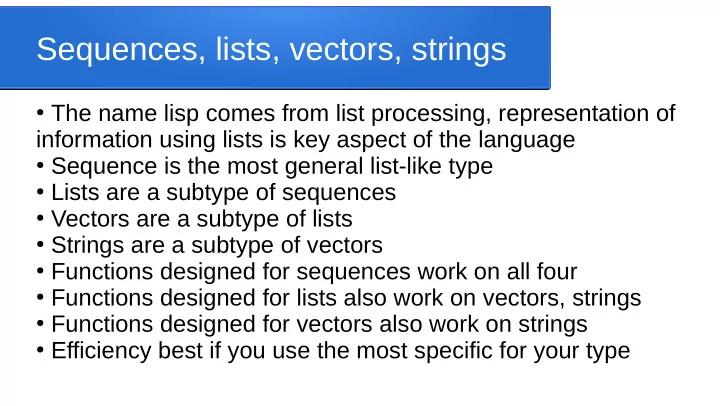

Sequences, lists, vectors, strings ● The name lisp comes from list processing, representation of information using lists is key aspect of the language ● Sequence is the most general list-like type ● Lists are a subtype of sequences ● Vectors are a subtype of lists ● Strings are a subtype of vectors ● Functions designed for sequences work on all four ● Functions designed for lists also work on vectors, strings ● Functions designed for vectors also work on strings ● Efficiency best if you use the most specific for your type
Basic syntax ● Basic syntax looks like a function, e.g. (x 10 “foo” 3.5), will need to come up with a way to distinguish them ● It’s ok to have empty lists, () ● Nil and empty list are treated as the same thing (so empty list also acts as false for boolean expressions) ● It’s ok to have lists inside lists, e.g. (1 2 (x y z)) and can be as deeply nested as desired, e.g. (“foo” (1.1 ( ((5 6) 4)(3 1)))) ● Can use listp, stringp, vectorp to check type
Quotes and sequences/lists/etc ● Need a way to tell the difference between a list and a function call, e.g. (x y z) looks like either ● Assumed to be a function call unless told otherwise, e.g. (1 2 3) is assumed to be calling function 1 on parameters 2 and 3 ● The list function returns a list, e.g. (list 1 2 3) ● The quote function tells lisp to treat as data, not a function call, e.g. (quote (1 2 3)) does not treat (1 2 3) as a function call ● Putting a single quote in front acts same as quote function, e.g. ‘(1 2 3) means treat it as data, not a function call
Common lisp programming errors ● Putting the function name in front of the bracket (e.g. f(x) instead of (f x) ● missing/extra/misplaced brackets (use a good editor) ● forgetting to type-check parameters or user input ● putting a quote in front of something you intended to be a function call ● forgetting a quote in front of something you meant to be a list of data
Quotes in other contexts ● The single quote, or the quote function, are often used to tell lisp not to evaluate something, e.g. ● ‘x means the symbol x, don’t evaluate as the variable x or function name x
Sequence functions ● (length S) returns length of sequence S ● (elt S i) returns ith element of S ● (setf (elt S i) x) sets ith element to x ● (count e S) counts how often e appears in S ● (remove e S) remove all e’s from S ● (copy-seq S) returns a duplicate of S ● (sort S OP) sorts s using OP for comparison, e.g. (sort S ‘<) ● (concatenate TYPE S1 S2) returns concatenation of sequences S1 and S2, type can be ‘list, ‘string, ‘vector
Some list functions ● (cons e L) returns list that has e as first element, followed by contents of L ● (car L) returns front element of L (crashes if L empty) ● (cdr L) returns list of all of L except front element ● (nth N L) returns Nth element of L ● (last L) returns last element of L ● (member e L) true iff e is in L ● (null L) true iff L is empty list ● (append L1 L2) returns list with elements of L1 then elements of L2
Combinations of car and cdr ● (cadr L) like (car (cdr L)) ● (cdar L) like (cdr (car L)) ● (cddr L) like (cdr (cdr L)) ● Etc, can use any sequence of up to 3 a’s and d’s ● Trivia: car came from content-address-register and cdr came from content-decrement-register, from original implementations way back in the 60’s
Some vector functions ● (vector x y z) builds/returns vector with elements x y z ● (svref V i) returns ith element of vector V ● (setf (svref V i) x) sets ith element to x ● And, of course, any of the list and sequence functions are usable on vectors
Programming with lists ● Lots of recursion, using car/cdr to decompose lists into head/tail, or cons to construct one element at a time ● Example: count the elements in a list (defun countElements (L) (cond ((not (listp L)) nil) ((null L) 0) (t (+ 1 (countElements (cdr L))))))
Example: append ● Want (append L1 L2) to return a list with all the elements of L1, followed by all the elements of L2 ● First element of L1 will be front, the rest can be build by appending the rest of L1 with L2 (defun append (L1 L2) (cond ((or (not (listp L1)) (not (listp L2))) nil) ((null L1) L2) ((null L2) L1) (t (cons (car L1) (append (cdr L1) L2)))))
Example: reverse a list ● Will use a helper function and build up a list of the elements we’ve reversed so far (defun reverse (L) (if (not (listp L)) nil (revHelp L ‘()))) (defun revHelp (LR sofar) (cond ((null LR) sofar) (t (revHelp (cdr LR) (cons (car LR) sofar)))))
Arrays ● Can create multidimensional arrays by specifying the dimensions as a list (make-array ‘(3 4)) ; returns 3 x 4 array ● Can initialize elements when we create it, e.g. (make-array ‘(3 4) :initial-element 27) ; inits to 27 ● Can lookup dimension list using array-dimensions (array-dimensions myArray) ● Can look up the size of just the i’th dimenion (array-dimension myArray i)
Accessing array elements ● To look up an element, use aref with indices, e.g. ● (aref myArray i j) ; returns myArray[i][j] ● (setf (aref myArray i j) v) ; like myArray[i][j] = v
Recommend
More recommend